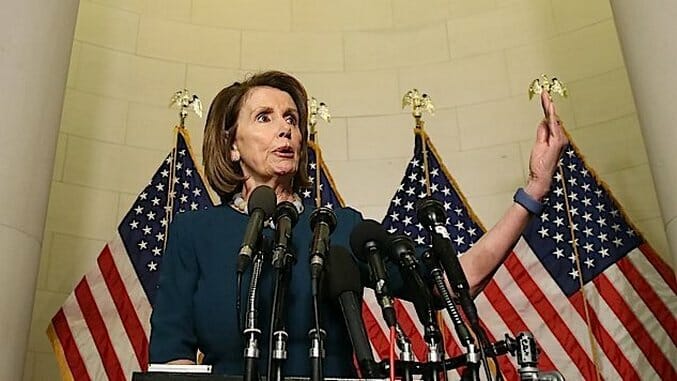
During CNN’s town hall last Tuesday, Nancy Pelosi, the Democratic House Minority Leader, took a question from college student Trevor Hill.
Hill cited a Harvard University poll showing 51 percent of people between the ages of 18 and 29—not just Democrats, not just leftists—no longer support the system of capitalism.”
Pelosi had an immediate, physical, reaction; she recoiled at the mere suggestion capitalism is losing favor among large swaths of the population. Hill continued, noting that, as a gay man, he has been “excited to see Democrats move left on social issues.”
But his question for Pelosi was: Are Democrats open to moving “farther left to a more populist message” on economic issues, creating “a more stark contrast” to right-wing economics?
Pelosi’s response was quick and sure. After all, she couldn’t let anyone get the wrong impression. “Well I thank you for your question,” she said, “but I have to say, we’re capitalist, and that’s just the way it is.”
The House Minority Leader went on to tell a story whose motive was to distinguish between two different capitalisms, one that is good to those at the bottom of income distribution and one that is not. We have entered the age of shareholder capitalism, Pelosi alleged, and that is why CEO pay continues to climb while the average worker sees little to no income growth.
She went on to argue the income inequality we see today is “an immorality,” the “free market” remains “a place that can do good things.”
There’s a reason such talk sounds shallow: For a majority of the population, the so-called “free market” hasn’t worked for a long time. For millennials like Trevor, capitalism appears to have outlived its usefulness; as Fredrik deBoer noted, “only about half of 30-year-old workers in America earn more than their parents did at the same age.”
“Compare that to previous generations,” deBoer added. “In 1940, 92% of Americans in their 30s earned more than their parents did at the same age. That’s a vast drop.”
And, to be sure, it’s not just young people who are feeling the pain of stagnation and decline. As the economists Thomas Piketty, Emmanuel Saez, and Gabriel Zucman noted in a recent report, “For the 117 million U.S. adults in the bottom half of the income distribution, growth has been non-existent for a generation.” It is, they concluded, “a tale of two countries” — one enriched by the current order, one excluded entirely.
There are multiple factors at play here: Tax cuts for the rich, the decline of unions, a slow-growth economy. The financial collapse eliminated the wealth of middle- and low-income homeowners, and many have yet to regain their footing. Wage growth has been largely stagnant since the 1970s.
And Democrats — particularly corporate-wing Democrats like Nancy Pelosi — have failed to offer sufficiently ambitious solutions these crises. Hillary Clinton’s anti-poverty program is a case in point. Instead of offering a robust agenda, she put forward the usual technocratic, means-tested policies that would merely tinker around the edges while leaving the larger structural issues intact.
There was, however, a candidate who represented a significant departure from the status quo. Bernie Sanders called for a $15 minimum wage (Clinton, along with many other Democrats, pushed for $12), far higher taxes on the wealthy, a crackdown on Wall Street, free public college tuition, and single-payer health care.
In short, the Sanders agenda was one placing aggressive redistribution of wealth and power at the center. It was an approach that didn’t avoid class war, but recognized a vicious war has been waged from above for decades and urged the 99 percent to fight back. He called this program democratic socialism.
In direct contrast to Pelosi, Sanders, when asked by Chuck Todd in 2015 if he is a capitalist, responded with a blunt, “No, I’m a democratic socialist.”
One can argue the meaning of the label — is Sanders in fact a democratic socialist, or is he really a social democrat?
The significant point is Sanders garnered rather incredible enthusiasm, and tangible results, by alleging capitalism as such is ineffective at addressing the needs of most of the population. It has been ineffective for a long time and a new imagination is necessary if we are to tackle head-on the immense crises we face, from rampant poverty to climate change.
Despite what his critics alleged throughout the Democratic primaries, the Sanders coalition was quite diverse, and the most prominent dividing line between those who voted for the Vermont senator and those who voted for Clinton was not race or gender but age.
The young voters who overwhelmingly favored Sanders will shape the future political landscape. No longer will they tolerate answers like “that’s just the way it is” from Democrats who have for too long failed to address the failures of the status quo.
Writing in 1970, the economist John Kenneth Galbraith lamented the state of the Democratic Party of his time. He wrote that “if the test of the success of a party is the quality and number of its office holders, the Democrats are not doing well.”
If they are to recover, Galbraith argued, they must condemn the current order as toxic and ineffective, and rather than urging we return to what was, they must move in an entirely new direction.
“The Democratic Party must henceforth use the word socialism,” he argued. “It describes what is needed.”
For how much longer will Galbraith’s advice be ignored?
Jake Johnson is a freelance writer. Follow him on Twitter: @johnsonjakep